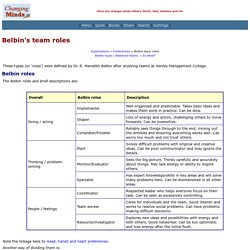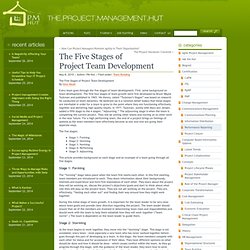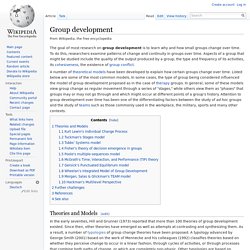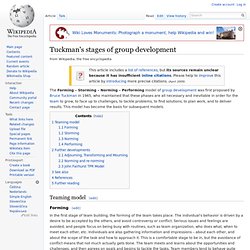

Maslow’s Hierarchy of Needs. Summary: Maslow’s Hierarchy of Needs (often represented as a pyramid with five levels of needs) is a motivational theory in psychology that argues that while people aim to meet basic needs, they seek to meet successively higher needs in the form of a pyramid.

Originator: Abraham Maslow in 1943. Key terms: deficiency needs, growth needs, physiological, safety, belongingness, esteem, self-actualization Maslow’s Hierarchy of Needs Abraham H. Maslow felt as though conditioning theories did not adequately acapture the complexity of human behavior. Maslow’s Hierarchy of Needs has often been represented in a hierarchial pyramid with five levels. Figure 1. Deprivation Needs The first four levels are considered deficiency or deprivation needs (“D-needs”) in that their lack of satisfaction causes a deficiency that motivates people to meet these needs. Growth Needs The highest level is self-actualization, or the self-fulfillment. Criticisms. Hierarchy of Needs. What motivates behavior?

According to humanist psychologist Abraham Maslow, our actions are motivated in order achieve certain needs. Maslow first introduced his concept of a hierarchy of needs in his 1943 paper "A Theory of Human Motivation" and his subsequent book Motivation and Personality. This hierarchy suggests that people are motivated to fulfill basic needs before moving on to other, more advanced needs.
This hierarchy is most often displayed as a pyramid. The lowest levels of the pyramid are made up of the most basic needs, while the more complex needs are located at the top of the pyramid. As people progress up the pyramid, needs become increasingly psychological and social. 2000px-Maslow's_hierarchy_of_needs.svg.png (PNG Image, 2000 × 1309 pixels) - Scaled (51%) Belbin's Team Roles - Leadership Training from MindTools.
How Understanding Team Roles Can Improve Team Performance © iStockphoto When a team is performing at its best, you'll usually find that each team member has clear responsibilities.

Just as importantly, you'll see that every role needed to achieve the team's goal is being performed fully and well. But often, despite clear roles and responsibilities, a team will fall short of its full potential. Belbin's Team Roles. Explanations > Preferences > Belbin team roles Belbin types | Balanced teams | So what?

These types (or 'roles') were defined by Dr. R. Meredith Belbin after studying teams at Henley Management College. Belbin roles. Belbin's Team Roles - Leadership Training from MindTools.com. How Understanding Team Roles Can Improve Team Performance © iStockphoto When a team is performing at its best, you'll usually find that each team member has clear responsibilities.

Just as importantly, you'll see that every role needed to achieve the team's goal is being performed fully and well. But often, despite clear roles and responsibilities, a team will fall short of its full potential. How often does this happen in the teams you work with? Dr Meredith Belbin studied team-work for many years, and he famously observed that people in teams tend to assume different 'team roles.' Creating More Balanced Teams Belbin suggests that, by understanding your role within a particular team, you can develop your strengths and manage your weaknesses as a team member, and so improve how you contribute to the team.
Belbin's Team Roles - Leadership Training from MindTools.com. Meredith Belbin. Meredith Belbin is a British researcher and management theorist best known for his work on management teams.

He is a visiting professor and Honorary Fellow of Henley Management College in Oxfordshire, England. Early life and work[edit] Raymond Meredith Belbin was born in 1926. He took both his first and second degrees, Classics and then Psychology at Clare College, Cambridge. His first appointment after his doctorate was as a research fellow at Cranfield College (now Cranfield School of Management at Cranfield University). It was while at ITRU, in the late 1960s, that Belbin was invited to carry out research at what was then called the Administrative Staff College at Henley-on-Thames. In 1988, Belbin established, with his son Nigel, Belbin Associates to publish and promote his research. Team Role Theory - Belbin Team Roles. HANDOUT_-_Tuckmans_Team_Development_Model.pdf. The Five Stages of Project Team Development. May 8, 2010 | Author: PM Hut | Filed under: Team Building The Five Stages of Project Team Development By Gina Abudi Every team goes through the five stages of team development.

First, some background on team development. The first four stages of team growth were first developed by Bruce Wayne Tuckman and published in 1965. His theory, called “Tuckman’s Stages” was based on research he conducted on team dynamics. The five stages: Stage 1: FormingStage 2: StormingStage 3: NormingStage 4: PerformingStage 5: Adjourning This article provides background on each stage and an example of a team going through all five stages.
Group development. The goal of most research on group development is to learn why and how small groups change over time.

To do this, researchers examine patterns of change and continuity in groups over time. Aspects of a group that might be studied include the quality of the output produced by a group, the type and frequency of its activities, its cohesiveness, the existence of group conflict. A number of theoretical models have been developed to explain how certain groups change over time.
Listed below are some of the most common models. Tuckman's stages of group development. The Forming – Storming – Norming – Performing model of group development was first proposed by Bruce Tuckman in 1965, who maintained that these phases are all necessary and inevitable in order for the team to grow, to face up to challenges, to tackle problems, to find solutions, to plan work, and to deliver results.

This model has become the basis for subsequent models. Teaming model[edit] Forming[edit] In the first stage of team building, the forming of the team takes place. The individual's behavior is driven by a desire to be accepted by the others, and avoid controversy or conflict. The forming stage of any team is important because the members of the team get to know one another, exchange some personal information, and make new friends. Storming[edit] In the storming stage, enough initial trust has been developed between team members that they start to feel comfortable expressing discontent and challenging others' opinions.
Norming[edit] Mc_team_development.pdf.